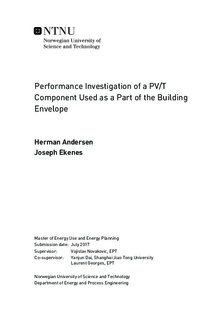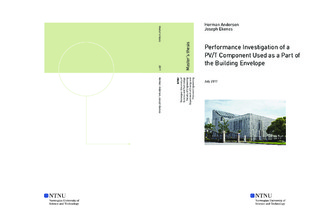| dc.description.abstract | The goal of this master thesis is to analyse and develop design methods for building integrated photovoltaic/thermal (BIPV/T) technology at the Green Energy Laboratory (GEL) at Shanghai Jiao Tong University (SJTU) in China.
PV/T technology generates electrical and thermal energy in a smaller area, compared to solely PV panels and solar collectors. For a PV panel, the electrical efficiency will decrease when the surface temperature increases, typically during peak solar irradiation. The air or water circulating in the PV/T component cools the PV surface, maintaining higher efficiency and thus higher energy generation.
A water based PV/T component has been calibrated and validated according to measurements conducted in Shanghai, China. Furthermore, the component was used to model a PV/T façade at the south wall of GEL. A façade integrated PV/T system utilising air as heat transfer medium was also modelled, but not validated, as no measurements were available for this component.
The BIPV/T systems were optimised for five parameters; dead band, storage tank size, mass flow rate, tank inlet height from heat source and tank inlet height from mains water supply. Simulations have been conducted to analyse the effect of building integration, both on the building energy demand and the BIPV/T system operation. Simulations were carried out for the same building model with air based BIPV/T system, water based BIPV/T system, air based PV/T system, water based PV/T system and PV façade (BIPV).
The results show that PV/T integrated to the building façade has negligible effect on the total energy demand of the building. The electrical efficiency was highest for the air based BIPV/T system and the water based BIPV/T showed the largest amount of collected thermal useful energy. The BIPV showed the highest electrical solar fraction, as a significant amount of fan energy required for operation of the air based BIPV/T system results in reduced solar fraction for that system. | |

